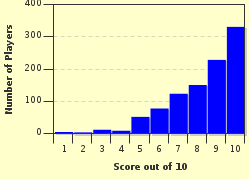Quiz Answer Key and Fun Facts
1. I was an ancient Greek mathematician and mystic. I had a colorful, if somewhat obscure, early life in the eastern Mediterranean before I founded a religious and philosophical society in Croton based around mathematics. I swore all of my followers to strict secrecy, so it SHOCKS me that anything leaked out.
Now everyone knows me for a little theorem about right triangles. I didn't even discover it; the Babylonians beat me to it by 1000 years. Who am I?
2. I was a Medieval mathematician. I was born in Pisa, but I grew up in North Africa, where I was exposed to the vast scientific and mathematical knowledge of the East. I was famous in my time for writing a book called the "Liber Abbaci," which introduced the decimal system to Europe and described how to do basic arithmetic with it. This was also the first time anyone in Europe had ever used a symbol for the number zero!
However, you probably know me best for the series of numbers that begins 0, 1, 1, 2, 3, 5... I didn't invent it; I just borrowed it for a problem in my "Liber Abbaci." Who am I?
3. I was a 19th century German chemist. I was the first to synthesize isobutyric acid, guanide, creatine, creatinine, and tyrosine. I also discovered an important rule about alcohols, which is named after me.
But that's not what my name makes most people think of! It's the clever flask I invented! And I bet they can't even remember my full name, much less spell it right. Who am I?
4. I was a 19th century German chemist. I pioneered the fields of emission spectroscopy and photochemistry, and I also co-discovered two elements, cesium and rubidium. Despite these accomplishments, I'm best remembered for my nifty little burner, which made much of my work possible. Who am I?
5. I was a 19th century French chemist. My accomplishments are so many that they are hard to list: I developed vaccination, discovered the germ theory of disease, proposed the existence of viruses, invented stereochemistry... Today, you can see my name on almost any milk carton. Who am I?
6. I was a 19th century German mathematician and astronomer. I developed a lot of math: there's my configuration, formed by two mutually inscribed tetrahedra, my transformation in number theory, my transformations in projective geometry, my function, and my inversion formula. Pretty nifty, eh?
You're probably most familiar with the strip named after me, a two-dimensional surface with only one side. Who am I?
7. I was a 20th century physicist at Princeton and MIT. I designed apparatus for experiments in radiation and particle physics. My eponymous invention, a static electricity generator, has been superseded by other, higher energy devices. But, it is still used for demonstrations in classrooms and science museums worldwide. Who am I?
8. I was a 20th century German physicist. I did extensive work on radioactivity with Ernest Rutherford, and devised a formula, named after me, for the velocities of particles. I contributed to the discovery of the atomic nucleus, and participated in Germany's effort to build an atom bomb.
The radiation counter I developed and steadily improved upon is still used today. Who am I?
9. I was a 20th century Swiss psychiatrist. I acted as the director of several asylums, and I pursued research in the psychoanalysis and psychopathology of religion.
I also had a deep interest in art, and my love of inkblots led to my most famous test. My schoolmates even called me "Klex," which meant "inkblot." Who am I?
10. Born in Vienna, Austria, I was a twentieth century physicist who helped develop modern quantum theory. My wave equation was one of my greatest discoveries, and I received a Nobel Prize for it.
But, you've probably heard of me because of my cat. Is it alive, or is it dead? Let's open the box. Who am I?
Source: Author
pu2-ke-qi-ri
This quiz was reviewed by FunTrivia editor
Snowman before going online.
Any errors found in FunTrivia content are routinely corrected through our feedback system.

